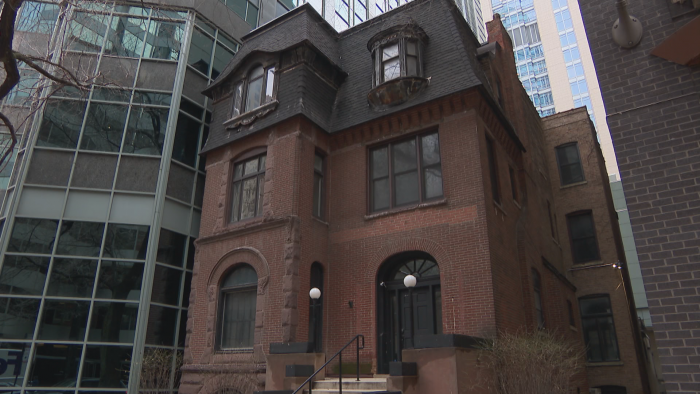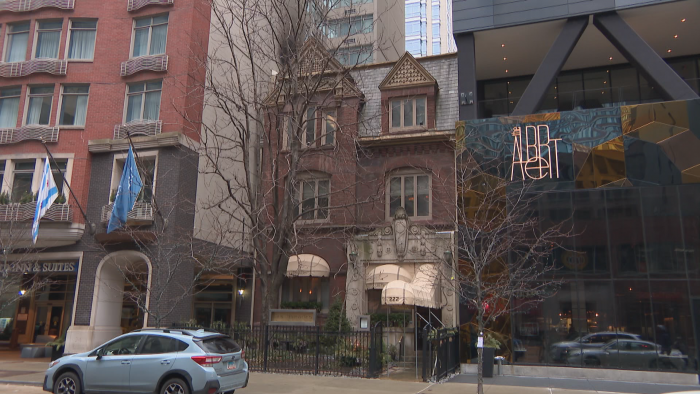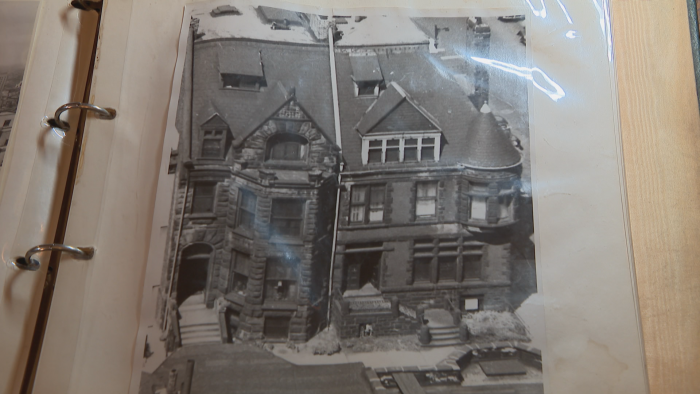Fifteen historic buildings in the Near North neighborhood are headed for landmark status following a vote Thursday by the city’s landmarks commission. The buildings represent a key moment in the city’s history – and their landmark status, if eventually approved by the full City Council, would mean some restrictions for owners.
One of those owners, John Connellan, moved into his building on Rush Street some 30 years ago. That very day, he says, a guy walked in and asked if he was the new owner.
“And I said, ‘Yep,’ and he said, ‘Would you like some pictures of it?’” Connellan said.
The visitor said he used to be a newspaper photographer and still had some pictures of Connellan’s house and the surrounding neighborhood. Connellan, who has held on to those photos for decades, says he loves the history behind his building. It’s one of 15 on the Near North Side that was built in the late 1800s that advocates are now trying to preserve. Though many of the buildings – beautifully designed and crafted two-, three- and four-story structures – are now businesses, they originally housed well-to-do Chicagoan.
“You walk down the street and you see a lot of tall buildings going up, and then you see these wonderful little row houses that have these charming little businesses in them,” said Ward Miller of Preservation Chicago. “The human scale of these structures … really gives a sense of place, a sense of history.”
The buildings also represent a fresh start. Built in the years after the devastating Great Chicago Fire of 1871, half the buildings are Italianate, built of brick and limestone with elaborate carvings above the windows and doors. The others are a mix of Queen Anne, with asymmetrical form and varied colors and textures; and Second Empire, with a French influence. Some have a medieval flair from Romanesque details. Some of the architects behind the homes were also responsible for remarkable buildings like the Newberry Library, the Ryerson House in Kenwood and the Chicago Athletic Association.
Lisa DiChiera of Landmarks Illinois describes the 15 buildings as “survivors.”
“The amount of development that has happened in this neighborhood, the Near North neighborhood particularly over the last 30 years, has really wiped out a lot of the remnants of the late 19th century development,” DiChiera said.
Despite their historic value, some property owners are worried that preservation efforts are going to tie their hands and potentially make future sales difficult.
If the landmark designation is approved, owners wouldn’t be able to tear down the buildings or make any changes to their historic facades, though they could change their interiors. Connellan says he doesn’t think teardowns are in the offing, but he’s heard other concerns at public hearings. One neighbor, he says, voiced fears about finding a future buyer if the building becomes a landmark.
“As he said, ‘This is my retirement, but if I can’t get the money out of the building, I don’t have a retirement,” Connellan said. “To me, (the city is) not selling this concept.”
Preservation advocates say they understand owners’ concerns. But they’ve also watched the fabric of the city change – and have seen historic architecture disappear.
“When I was growing up in this neighborhood, just a little to the north, there were a number of mansions and row houses that were converted to restaurants and businesses,” Miller said. “A lot of those have gone, and have been replaced by tall buildings.”
In fact, an application to demolish two of the buildings on Superior Street prompted the city to review the structures and move to preserve them.
“Without these buildings we really would have no understanding of what the city looked like in that early development period,” DiChiera said. “If they’re gone, they’re gone forever.”
While it’s not a done deal yet, Connellan says, “You can’t beat City Hall.”
At Thursday’s hearing, city staff noted the ordinance has been written to reflect owners’ concerns, and would allow visible additions at the rear of the buildings if they were significantly set back from the street. The commission’s recommendation still has to be introduced in City Council. Final approval could come as early as next month.
The commission also recommended landmark status for the Blackwell-Israel Samuel A.M.E. Zion Church Building at 3956 S. Langley Ave. in Bronzeville and the Chicago & North Western Railway Office Building at 226 W. Jackson Boulevard.






















